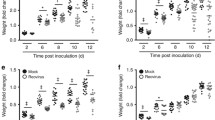Summary
Four-week-old weanling mice survived, whereas 1-week-old suckling mice died, after intraperitoneal inoculation of mouse hepatitis virus, MHV-S strain. The factors involved in this difference in susceptibility were studied. After virus inoculation, differences in virus growth in the liver and spleen were observed, which correlated with the susceptibility of animals to the virus. Interferon, detected at an early stage of infection, was considerably lower in suckling mice than in weanling mice. Titers of MHV-S in peritoneal cells from infected animals were at least 100 times greater in suckling than in weanling mice, and a similar, but less prominent difference in virus growth was also found in the corresponding cultured macrophages. After transfer of peritoneal cells from weanling to suckling mice, a decrease in mortality of infected suckling mice was observed. These results suggest that both interferon and macrophages may be important in the age-dependent resistance of mice to MHV-S infection.
Similar content being viewed by others
References
Broderson, J. R., Murphy, F. A., Hierholzer, J. C.: Lethal enteritis in infant mice caused by mouse hepatitis virus. Lab. Anim. Sci.26, 824 (1976).
Fujiwara, K.: Problems in checking inapparent infections in laboratory mouse colonies. An attempt at serological checkings by anamnestic response. In:Schneider, H. A. (ed.), Defining of the laboratory animals, 77–92. Washington, D.C.: National Academy Science 1971.
Gallily, R., Warwick, A., Bang, F. B.: Ontogeny of macrophage resistance to mouse hepatitis virusin vivo andin vitro. J. exp. Med.125, 537–548 (1967).
Heineberg, H., Gold, E., Robbins, F. C.: Differences in interferon content in tissues of mice of various ages infected with Coxsackie B1 virus. Proc. Soc. exp. Biol. Med.115, 947–953 (1964).
Hirano, N., Fujiwara, K., Hino, S., Matumoto, M.: Replication and plaque formation of mouse hepatitis virus (MHV-2) in mouse cell line DBT culture. Arch. ges. Virusforsch.44, 298–302 (1974).
Hirsh, M. S., Zisman, B., Allison, A. C.: Macrophage and age-dependent resistance to herpes simplex virus in mice. J. Immunol.10, 1160–1165 (1970).
Hotchin, J., Weigand, H.: Studies of lymphocytic choriomeningitis in mice. 1. The relation ship between age at inoculation and outcome of infection. J. Immunol.86, 392–400 (1961).
Ishida, T., Taguchi, F., Lee, Y., Yamada, A., Tamura, T., Fujiwara, K.: Isolation of mouse hepatitis virus from infant mice with fatal diarrhea. Lab. Anim. Sci.28, 269–276 (1978).
Kunin, C. M.: Virus-tissue union and the pathogenesis of enterovirus infection. J. Immunol.88, 556–568 (1962).
Levy-Leblond, E., Dupuy, J. M.: Neonatal susceptibility to MHV3 infection in mice. J. Immunol.118, 1219–1222 (1977).
Mogensen, S. C.: Macrophage and age-dependent resistance to hepatitis induced by herpes simplex virus type 2 in mice. Infect. Immun.19, 46–50 (1978).
Morahahn, P. S., Glasgow, L. A., Crane, J. L., Jr., Kern, E. R.: Comparison of antiviral and antitumor activity of activated macrophages. Cell. Immunol.28, 404–415 (1977).
Rowe, W. P., Hartley, J. W., Capps, W. I.: Mouse hepatitis virus infection as a highly contagious, prevalent, enteric infection of mice. Proc. Soc. exp. Biol. Med.112, 161–165 (1963).
Taguchi, F., Aiuchi, M., Fujiwara, K.: Age-dependent response of mice to a mouse hepatitis virus, MHV-S. Japan. J. exp. Med.47, 109–115 (1977).
Taguchi, F., Hirano, N., Kiuchi, Y., Fujiwara, K.: Difference in response to mouse hepatitis virus among susceptible mouse strains. Japan. J. Microbiol.20, 293–302 (1976).
Taguchi, F., Goto, Y., Aiuchi, M., Hayashi, T., Fujiwara, K.: Pathogenesis of mouse hepatitis virus infection: The role of nasal epithelial cells as a primary target of low-virulence virus, MHV-S. Microbiol. Immunol.23, 249–262 (1979).
Taguchi, F., Yamada, A., Fujiwara, K.: Asymptomatic infection of mouse hepatitis virus in the rat. Arch. Virol.59, 275–279 (1979).
Virelizier, J. L., Allison, A. C., De Maeyer, E.: Production by mixed lymphocyte cultures of a type II interferon able to protect macrophages against virus infection. Infect. Immun.17, 282–285 (1977).
Virelizier, J. L., Gresser, I.: Role of interferon in the pathogenesis of viral diseases of mice demonstrated by the use of anti-interferon serum. V. Protective role in mouse hepatitis virus type 3 infection of susceptible and resistant strains of mice. J. Immunol.120, 1616–1619 (1978).
Author information
Authors and Affiliations
Additional information
With 4 Figures
Rights and permissions
About this article
Cite this article
Taguchi, F., Yamada, A. & Fujiwara, K. Factors involved in the age-dependent resistance of mice infected with low-virulence mouse hepatitis virus. Archives of Virology 62, 333–340 (1979). https://doi.org/10.1007/BF01318107
Received:
Accepted:
Issue Date:
DOI: https://doi.org/10.1007/BF01318107




